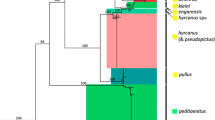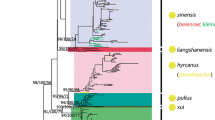Abstract
Anopheles funestus sensu stricto is a major malaria vector in Africa. Recently, two clades were identified in this species based on mitochondrial DNA sequence data. We investigated differences between the two An. funestus clades based on nuclear genes and internal transcribed spacer 2 (ITS2) in the ribosomal DNA. Samples were collected from Malawi and Mozambique and were then used to sequence five nuclear genes (BU21, 9K1, 6Z3, BU021 and BU92) and the ITS2 region. The DNA sequence data was used to assess the diversity of the two An. funestus clades. We identified 12, 10, 24, 10, and 21 polymorphisms in the two An. funestus clades in the BU21, 9K1, 6Z3, BU021, and BU92 genes, respectively. No differences or polymorphisms were found in the ITS2 region between the two clades. This report assesses the diversity of the two An. funestus clades based on nuclear genes and the ITS2 region. Single nucleotide polymorphisms were found between the two clades of An. funestus. This could be explained by the existence of remaining introgression regions in the genomes of the two An. funestus clades and limited divergent regions. Further investigation is needed to determine the specific status of the two clades within An. funestus.

Similar content being viewed by others
References
Ballinger-Crabtree ME, Black WC, Miller BR (1992) Use of genetic polymorphisms detected by the random-amplified polymorphic DNA polymerase chain reaction (RAPD-PCR) for differentiation and identification of Aedes aegypti subspecies and populations. Am J Trop Med Hyg 47:893–901
Beckingham K (1982) Insect rDNA. In: Busch H, Tothblum L (eds) The cell nucleus. Academic Press, New York, pp 205–263
Brumfield RT, Beerli R, Nickerson DA, Edwards SV (2003) The utility of single nucleotide polymorphisms in inferences of population history. Trends Ecol Evol 18:249–256
Choi KS, Koekemoer LL, Coetzee M (2012) Population genetic structure of the major malaria vector Anopheles funestus s.s. and allied species in southern Africa. Parasit Vectors 5:283
Choi KS, Koekemoer LL, Coetzee M (2013) Detection of clade types (clades I and II) within Anopheles funestus sensu stricto by the hydrolysis probe analysis (Taqman assay). Parasit Vectors 6:173
Choi KS, Christian R, Nardini L, Wood OR, Agubuzo E, Muleba M, Munyati S, Makuwaza A, Koekemoer LL, Brooke BD, Hunt RH, Coetzee M (2014) Insecticide resistance and role in malaria transmission of Anopheles funestus populations from Zambia and Zimbabwe. Parasit Vectors 7:464
Coetzee M, Koekemoer LL (2013) Molecular systematics and insecticide resistance in the major African malaria vector Anopheles funestus. Annu Rev Entomol 58:393–412
Coetzee M, Hunt RH, Wilkerson R, Della Torre A, Coulibaly MB, Besansky NJ (2013) Anopheles coluzzii and Anopheles amharicus, new members of the Anopheles gambiae complex. Zootaxa 3619:246–274
De Meillon B, Van Eeden GJ, Coetzee L, Coetzee M, Meiswinkel R, Du Toit LN, Hansford CF (1977) Observations on a species of the Anopheles funestus subgroup, a suspected exophilic vector of malaria parasites in northeastern Transvaal. S.Afr Mosq News 37:657–661
Garros C, Koekemoer LL, Kamau L, Awolola TS, Van Bortel W, Coetzee M, Coosemans M, Manguin S (2004) Restriction fragment length polymorphism method for the identification of major African and Asian malaria vectors within the Anopheles funestus and An. minimus groups. Am J Trop Med Hyg 70:260–265
Gillies MT, Coetzee M (1987) A Supplement to the anophelinae of Africa South of the Sahara (Afrotropical Region), vol 55. Publications of the South African Institute for Medical Research, Johannesburg
Gillies MT, de Meillon B (1968) The Anophelinae of Africa South of the Sahara, vol 54. Publications of the South African Institute for Medical Research, Johannesburg
Hall TA (1999) Bioedit: a user-friendly biological sequence alignment editor and analysis program for Windows 95/98/NT. Nucleic Acids Symp Series 41:95–98
Harbach RE (2004) The classification of genus Anopheles (Diptera: Culicidae): a working hypothesis of phylogenetic relationships. Bull Entomol Res 94:537–553
Koekemoer LL, Kamau L, Hunt RH, Coetzee M (2002) A cocktail polymerase chain reaction assay to identify members of the Anopheles funestus (Diptera: Culicidae) group. Am J Trop Med Hyg 66:804–811
Koekemoer LL, Kamau L, Garros C, Manguin S, Hunt RH, Coetzee M (2006) Impact of the rift valley on restriction fragment length polymorphism typing of the major African malaria vector Anopheles funestus (Diptera: Culicidae). J Med Entomol 43:1178–1184
Michel AP, Guelbeogo WM, Grushko O, Schemerhorn BJ, Kern M, Willard MB, Sagnon N, Costantini C, Besansky NJ (2005) Rangewide population genetic structure of the African malaria vector Anopheles funestus. Mol Ecol 14:4235–4248
Morin PA, Luikart G, Wayne RK, the SNP workshop group (2004) SNPs in ecology, evolution and conservation. Trends Ecol Evol 19:208–216
Morlais I, Severson DW (2003) Intraspecific DNA variation in nuclear genes of the mosquito Aedes aegypti. Insect Mol Biol 12:631–639
Porter CH, Collins FH (1991) Species-diagnostic differences in a ribosomal DNA internal transcribed spacer from the sibling species Anopheles freeborni and Anopheles hermsi (Diptera: Culicidae). Am J Trop Med Hyg 45:271–279
Rozas J, Sanchez-Delbarrio JC, Messeguer X, Rozas R (2003) DnaSP, DNA polymorphism analyses by the coalescent and other methods. Bioinformatics 19:2496–2497
Wang DG, Fan JB, Siao CJ, Berno A, Young P, Sapolsky R, Ghandour G, Perkins N, Winchester E, Spencer J (1998) Large-scale identification, mapping, and genotyping of single-nucleotide polymorphisms in the human genome. Science 280:1077–1082
Wilkes TJ, Matola YG, Charlwood JD (1996) Anopheles rivulorum, a vector of human malaria in Africa. Med Vet Entomol 10:108–110
Wondji CS, Hemingway J, Ranson H (2007) Identification and analysis of single nucleotide polymorphisms (SNPs) in the mosquito Anopheles funestus, malaria vector. BMC Genom 8:5
Acknowledgments
This work was supported by the Department of Science and Technology, National Research Foundation Research Chair Initiative Grant to Prof. Maureen Coetzee at the University of the Witwatersrand in South Africa and the Hillel Friedland Fellowship to KSC.
Conflict of interest
The authors declare no conflict of interest.
Author information
Authors and Affiliations
Corresponding author
Rights and permissions
About this article
Cite this article
Choi, K.S. Diversity of clades I and II within Anopheles funestus sensu stricto in southern Africa. Genes Genom 37, 193–197 (2015). https://doi.org/10.1007/s13258-014-0236-3
Received:
Accepted:
Published:
Issue Date:
DOI: https://doi.org/10.1007/s13258-014-0236-3




